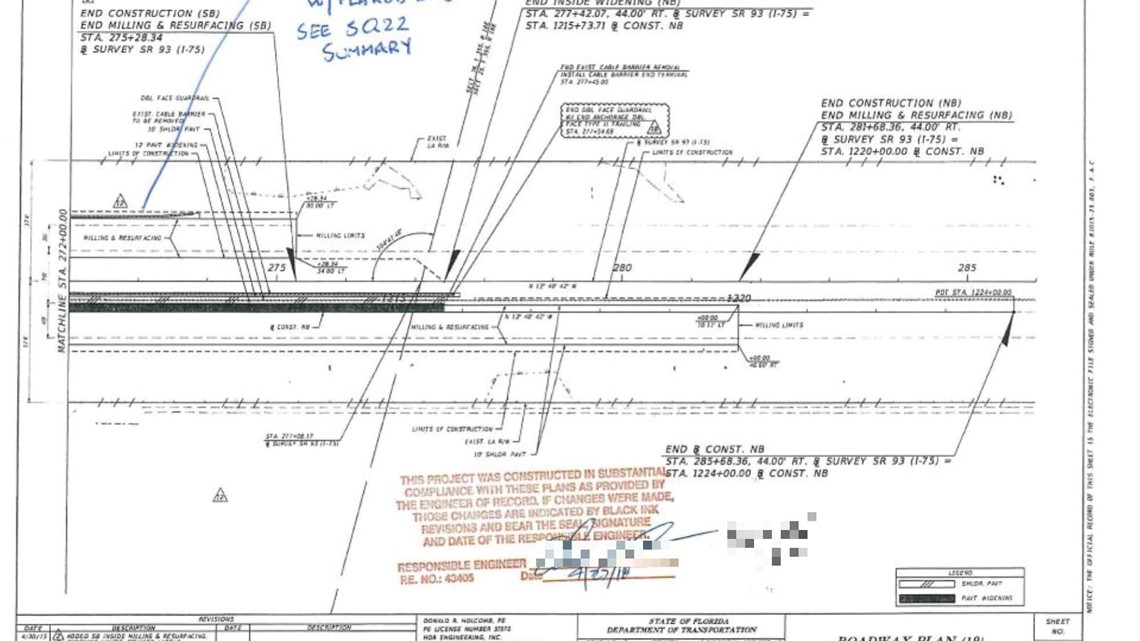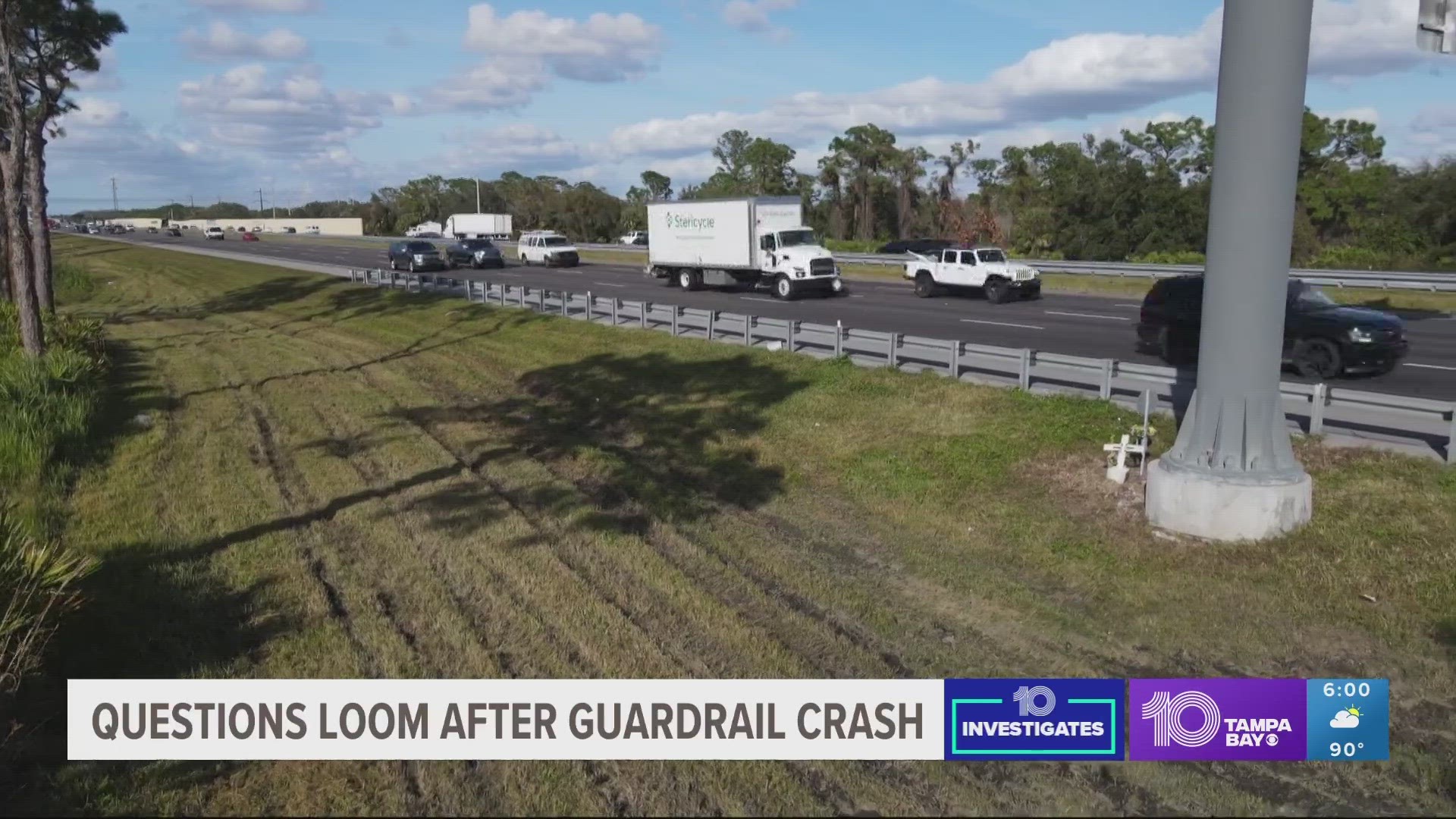SARASOTA, Fla. — The pain of losing a child is unimaginable.
“Hunter was loved by so many people,” said Christy DeFilippo, Hunter Burns' mother. “We will do whatever it takes for this to be changed.”
Burns, 22, died in an accident in March 2020. His truck crashed into a guardrail along Interstate 75 in Manatee County. Since the accident, his family has continued to search for answers.
“I don’t know if the guardrail would save Hunter, but knowing what I know now, the guardrail failed miserably protecting anybody on the roadway,” DeFilippo said.
10 Investigates has learned the guardrail was not only improperly installed, but it was also "frankensteined."


"'Frankensteining' goes back to the monster Frankenstein. It’s when you take parts from different systems and mix them together and what you got is a monster," said Steve Eimers, a safety advocate.
Eimers has unfortunately found many "monsters" on the side of the road.
"'Frankensteined' guardrails to the public, to most DOT workers, they are going to look right, but the thing is they don’t work," Eimers said.
He says after looking at what was installed at the side of the road where Burns crashed, it was never going to work.
“This is one of the most egregious installations I have ever found involving a fatal crash what happened and it can’t happen. We had a 22-year-old man hit a post and incinerated — yeah, I am mad, and I think people with the state of Florida should be mad, too,” Eimer said.
So when and how did this guardrail become improperly installed? We requested the certificate of compliance for the guardrail when the guardrail was first installed back in 2018. There’s a signed stamp that reads, “this project was constructed in substantial compliance with these plans as provided by the engineer of record.”


But our experts say the certificate and what was installed on the side of the road a month later do not match. We sent the certificate of compliance and photos to structural engineer, Kevin Schrum.
We had him compare the certificate of compliance to the Google Street View images of the guardrail — one from June 2018, a month after the final acceptance of the guardrail’s documents were signed, and the image from September 2019 taken just before Burns crashed.
Schrum says that the guardrail in the 2018 photo was improperly installed. It was upside down and backward.
“Sometimes the, the certification process is a little bit not as robust as it should be,” Schrum said.
We reached out to FDOT looking for answers as to whether this is the only form of documentation, they have regarding what’s being installed on the side of the roads.
They declined an on-camera interview but told us in a statement, in part:
"As for the Certificate of Compliance, it is important to offer some clarifying details as the certificate doesn’t represent how you have indicated. This item is specifically used with the initial construction of a total project not just guardrails individually—this means guardrails may be an element included with many aspects of a total project (roadway details, signage, pavement markers, etc.). This serves to affirm all components at the end of a construction project have been completed in accordance with the applicable plans and specifications. Once construction is complete, the project location transitions from being under construction to now falling under maintenance care.
"With the Certificate of Compliance related to only confirming design plans were accurately built during a specific construction project, the Certificate may no longer represent what is out in the field if there were changes at some point during needed maintenance (damage or replacement required). As an example, a certain type of guardrail currently in the field that is slated for repair may no longer be on our approved product list to reinstall the same type of guardrail that shows on the Certificate of Compliance/original construction, which means a different type of guardrail treatment from our approved product list would be installed over what is indicated from the past construction project."
Schrum noted changes in the photos from June 2018 and September 2019 indicating sometime during that timeframe, the guardrail was changed.
“It’s spliced together,” Schrum said. The guardrail at some point during those two years was turned into a “monster.”
“That is the issue here. The thing's supposed to keep you safe, there is no accountability for it. If someone crashes into it well figure it out then,” DeFilippo said.
One safety advocate tells us this shows you why more protocols need to be in place when it comes to installation and repairs.
Florida Department of Transportation Communications Director Jessica Ottaviano tells us:
“The Department understands the importance and necessity of routinely evolving practices and procedures with ever-changing designs, standards, and materials used on our facilities. As a reminder of the actions supporting our commitment to ensure the safety of our roadways is the added efforts to review guardrail concerns on our entire state system including the practices and training involved with them."
As for the full statewide review, FDOT tells us:
"The in-field review of guardrails statewide is a tedious and complex process that remains underway. With the complexity and carefulness of this review, the Department is diligently working to complete the in-field review and once the in-field review is completed, our team will need to gather and fully evaluate all information to provide insight to the review. We do not have an estimation of how long the full evaluation will take at this time."

